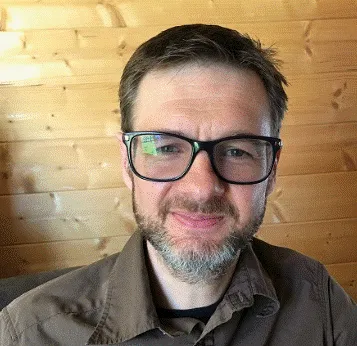Ben Kingston-Hughes, Inspired Children
Ben Kingston-Hughes is an international keynote speaker, author and multi award-winning trainer. He is also the Managing Director of Inspired Children and has worked with vulnerable children across the UK for over 35 years. He has appeared on television several times working on a variety of children’s projects and his distinctive blend of humour, neuroscience and real-life practical experiences have made his training invaluable for anyone working with children. His game-changing book about play, “A Very Unusual Journey into Play” has gained widespread acclaim and his new book, “Why Children Need Joy” was a finalist for a Nursery World Award for best professional book 2024, where it was awarded “highly commended”.
Essential Loose Parts Play.
We all know that play is amazingly good for children. We also know that there are lots of different types of play and they are each unique and special. However, my all-time favourite type of play is Loose Parts Play.
So, what makes Loose Parts Play special?
The original theory of Loose Parts play, proposed by Simon Nicholson in 1971, simply states that in any environment, “the degree of inventiveness and creativity, and the possibility of discovery, are directly proportional to the number and kind of variables in it.” [1]. In short, any resource or environment that offers multiple possibilities (or variables) has intrinsically greater play value and contributes more to the development of creativity and imagination. Basically, loose parts are any resources which allow children to explore and create their own outcomes, following their own interests and controlling the direction of their play.
Favourite resources.
Of course I have my favourite resources. I always have at least 30 flat-packed cardboard boxes in my van because they have an intrinsic play value far beyond modern children’s toys. One day they are towers, the next a giant robot or a tunnel system, vehicles, dens or even hats. It is this versatility which makes them such a great resource. In addition, they can be picked up for free which is always a plus. I am also never without a big bag of brightly coloured material because these are great for dens, costumes or even a big artwork across the entire floor. They can even be used as ropes or hammocks in a pinch!
However, it is not really about the resources but about what children do with them that is so unique. To truly understand just how special loose parts play is, we need to look at some fascinating neuroscience.
The neuroscience bit
Studies in laboratory mammals have shown that when they play, they produce a potent mix of biochemicals, many of which have powerful anti-depressant and anti-anxiety properties.
One example of this is Benzodiazepines which are a prescription grade anti-anxiety medication. In fact, the well-known (and incredibly potent!) drug, “Valium” is an actual Benzodiazepine, and children naturally produce this as they play.
Now it turns out that the same laboratory animals also produce these drugs when they forage or explore their environment. This means that curiosity also floods a child’s brain with benzodiazepines. Loose parts play, by simultaneously stimulating play and curiosity produces a significantly higher dosage of these vital chemicals.
We now know that Play and curiosity are primitive functions of our mammal brain and these behaviours have been ingrained in mammals for 200,000,000 years!
Even more drugs
However, the biochemical journey does not end there. Neurobiological studies into “happiness” have demonstrated that biochemicals such as serotonin, oxytocin and dopamine are produced in moments of happiness and when a child feels safe. These neurotransmitters also have strong anti-depressant properties which is just one more reason why play is such a powerful therapeutic discipline. Case studies suggest that when a child experiences joy, their emotional well-being is significantly improved and one of the primary ways in which we can increase levels of joy is through play. So, in addition to the chemicals associated with play and curiosity, loose parts play, if done right also produces the biochemicals associated with joy.
The power of surprise
However, something even more amazing is going on here. Dopamine is a vital “feel good” hormone which is essential for our well being and which our children need. However, there is a way to produce even more of this vital drug. Dopamine is part of our reward system so when, for instance, we get paid, having our wages in the bank may give us a small sense of satisfaction and a little hit of dopamine. Now compare that feeling to when you find a ten-pound note in your pocket that you didn’t know was there.[2] The degree of happiness seems to be disproportionate to the amount of money found. The reason is that Dopamine production massively increases when the happiness is surprising or unexpected. Loose parts play is therefore unique in this respect as the innate explorations and self-directed nature of this kind of play ensures that children are constantly creating novelty in their own world, effectively creating the “tenner in the pocket” feeling for themselves as they play and flooding them with increased dopamine.
Loose Parts PLAY and Imagination (A Playground of the mind)
Ok so here is where things get weird and wonderful. We have discussed primitive biochemical responses shared with all mammals but what about the uniquely human bits of our brain? Studies into the neuroscience of imagination have shown a significant amount of activity in the brain when using imagination. A large neural network (or mental workspace) is responsible for even simple imagination which means in imaginative play there is an extremely high level of brain activity. We also know that in childhood, areas of the brain which are used more often, actually grow more effectively. In short, imaginative play is an incredibly rich experience for children’s growing brains. Interestingly, the lead scientist behind one such experiment, Alex Schlegel[3] actually describes imagination as a playground.
“……the organization of our brains sets us apart from other species and provides such a rich internal playground for us to think freely and creatively,” Alex Schlegel
Far from being merely physical, Loose parts play involves a great deal of imagination as children are encouraged to see beyond what the objects are and imagine what they can be. By creating something new from disparate items, a child creates a firework display of activity in their brain making Loose Parts Play uniquely powerful at growing a child’s brain.
Bridging the gap between 200,000,000 years of evolution.
So Loose Parts Play is truly unique. First it activates the primitive mammal bits of our brain through simultaneously engaging the child in Play and Curiosity. This floods the child with benzodiazepines and other amazing biochemicals. Then through the ability to imagine possibilities in their play the child creates a huge amount of brain activity in the uniquely human bits of the brain, massively increasing the potential for brain growth and supporting them to become creative, problem-solving adults. All of this whilst creating more novelty in their play which significantly enhances dopamine production further increasing their well-being.
The tenner in the pocket feeling
In a world of electronic devices and single use toys the power of a few cardboard boxes and some supportive adults cannot be overstated. Children, more than ever need to explore and create within their play as these vital experiences are declining. I firmly believe that our children need and deserve to have the “tenner in the pocket” feeling every day and I believe that Loose Parts Play is a vital and often underrated method for doing just that.

[1] Simon Nicholson, “How NOT to Cheat Children – The Theory of Loose Parts,” Landscape Architecture, Volume 62 (1971): Page 30
[2] Berns, G.S, et al. ‘Predictability modulates human brain response to reward’, Journal of Neuroscience, 2001, 21
[3] Network structure and dynamics of the mental workspace, Alexander Schlegel, Peter J. Kohler, Sergey V. Fogelson, and Peter Ulric, University of California, Santa Barbara, CA, 2013
